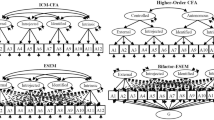Abstract
The purpose of this study was to develop a valid and relaible instrument to measure four areas of autonomy. The instrument is composed of four subscales that measure the following constructs of autonomy: (a) family loyalty autonomy, (b) value autonomy, (c) emotional autonomy, and (d) behavioral autonomy. A detailed four-step procedure was used to provide the scale with construct, content, and predictive validity. Presented here is the four-stage process used to develop the Autonomy Scale, data supporting the validity and reliability of the scale, and the final version of the instrument.
Similar content being viewed by others
References
Aiken, L. (1979).Psychological testing assessment. Boston: Allyn Bacon.
Ausubel, D. P., Montemayor, R., & Svajian, P. (1977).Theory and problems of adolescent development. (2nd ed.) New York: Grune & Stratton.
Blos, P. (1979).The adolescent passage: Developmental issues. New York: International Universities Press.
Boszormenyi-Nagy, I., & Ulrich, D. N. (1981). Contextual family therapy. In A. S. Gurman & D. P. Knisken (Eds),Handbook of family therapy (pp. 159–186). New York: Brunner/Marzel.
Bowen, M. (1974). Toward the differentiation of self in one's family of origin. In F. Andres & J. Loris (Eds.),Georgetown family symposia, 1 (1971–72). Washington, D.C.: Department of Psychiatry, Georgetown University Medical Center.
Bray, J., Williamson, D., & Malone, P. (1984). Personal authority in the family system: Development of a questionnaire to measure personal authority in intergenerational family processes.Journal of Marital and Family Therapy, 10, 167–178.
Chickering, A. W. (1967). The development of autonomy.American Journal of Orthopsychiatry, 37, 203–204.
Douvan, E. & Adelson, J. (1966).The adolescent experience. New York: John Wiley.
Fitts, W. H. (1965).Tennessee Self-Concept Scale. Los Angeles: Western Psychological Services.
Fogarty, T. (1975). Triangles.The Family, 2, 11–19.
Framo, J. (1976). Family of Origin as a therapeutic resource for adults in marital therapy: You can and should go home again.Family Process, 14, 193–210.
Framo, J. (1982).Explorations in marital and family therapy: Slected papers of James L. Framo. New York: Springer.
Haines, M. R. (1985), The life cycle, savings, and demographic adaptation: Some histoical evidence for the United States and Europes. In A. S. Rossi (Ed.),Gender and the life course (pp. 43–63), New York: Aldine.
Hare-Mustin, R. (1987). The problem of gender in family therapy theory.Family Process, 26, 15–27.
Havighurst, R. J., (1979).Developmental tasks and education (4th ed.). New York: David McKay Company.
Hoffman, L. W. (1972). Early childhood experiences and womens achievement motives.Journal of Social Issues, 28, 157–176.
Hogan, D. P. (1985), The demography of life-span transitions: Temporal and gender comparisons. In A. S. Rossi (Ed.),Gender and the life course (pp. 65–77). New York: Aldine.
Kiddler, L. H., Judd, C. M. & Smith, E. R. (1986).Research methods in social Relations (5th ed.), New York: Holt, Rinehart & Winston.
Leigh, G. K., & Peterson, G. W. (1986),Adolescents i familiesd. Cincinnati: Southwesten Publishing Co.
Osofsky, J. D., & Osofsky, H. J. (1984). Psychological and developmental perspectoves on expectan and new parenthood. In R. D. Parke (Ed.),Review of child development research (pp. 372–397). Chicago: University of Chicago Press.
Quintana, S. M., & Kerr, J. (1993). Relational needs in later adolescent separationindividuation.Journal of Counseling & Development, 71, 349–354.
Ryff, C. D. (1985). The subjective experience of life-span tramsitions. In A. S. Rossi (Ed.),Gender and the lifer course (pp. 97–113). New York: Aldine.
Stierlin, H., Levi, L. D., & Savard, R. J. (1971). Parental perceptions of separating children.Family Process, 10, 411–427.
Stierlin, H. (1985). Centripetal and centrifugal forces in the adolescent separation drama. In G. Handel (Ed.)The psychosocial interior of the family (3rd ed.) (pp. 339–365). New York: Aldine.
Strayer, F. F. (1984). Biologial approaches to the study of the family. In R. D. Parke (Ed.)Review of child development research (pp. 1–19). Chicago: University of Chicago Press.
White, R. (1975).Lives in progress: A study of the natural of persosnaliy. New York: Hol, Rinehart & Winston.
Williamson, D. (1981). Personal authority via termination the intergenerational hierarchical boundary: A “new” stage in the family life cycle.Journal of Marital and Family Therrappy, 7, 441–452.
Williamson, D. (1982a) Personal authority via termination of the intergenerational hierchical boundary: Part II. The consultation process and the therapeutic method.Journal of Marital and Family Therapy, 8, 23–28.
Williamson, D. (1982b). Personal authority in family experience via termination of the intergenerational hierachical boundary: Part III. Personal authority defined, and the power of play in the change process.Journal of Marital and Family Therapy, 8, 309–324.
Author information
Authors and Affiliations
Additional information
This article is based on dissertation research in partial fulfillment of degree requirements at Texas Woman's University.
Rights and permissions
About this article
Cite this article
Anderson, R.A., Worthington, L., Anderson, W.T. et al. The development of an autonomy scale. Contemp Fam Ther 16, 329–345 (1994). https://doi.org/10.1007/BF02196884
Issue Date:
DOI: https://doi.org/10.1007/BF02196884




